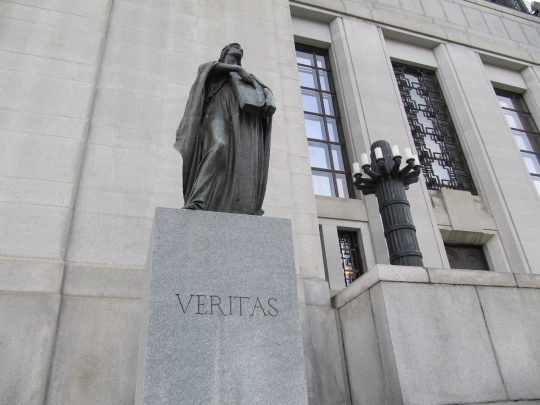Story by Kristine St-Pierre
Each week City Unlimited will examine a memorial, sculpture or work of public art that defines our urban outdoor space. These are more than inanimate objects; they are structures with surprisingly rich histories. It is our goal to bring these objects to life and tell you their stories.
Two statues originally commissioned to be part of a monument honouring King Edward VII, sat for more than 50 years in a box. Some say they were hidden under a parking lot, others say they were lost in government storage. But in 1969, Truth and Justice were discovered and installed in front of the Supreme Court of Canada.
Today, when you walk toward the Supreme Court of Canada, you can’t help but notice the imposing art deco structure of the building, adorned by a château-style roof. Built in the 1930s, the grey building is a few hundred metres from a bluff overlooking the Ottawa River.
If you look closely however, you’ll see that on either side of the building and almost blending into the background, are a pair of bronze statues, each three-metres high.
They are landmarks in their own right. The statues of Truth and Justice – from the Latin Veritas and Justicia – loom over the stairs leading up to the court’s entrance.
In Roman mythology, Veritas was the goddess of Truth. Portrayed as a young woman dressed in white, it is believed she hid in a holy well because she was so elusive. With delicate facial features and a long flowing gown, Veritas points to a book in hand inscribed “Veritas”.
Justicia, or goddess of Justice, is also more commonly known as Lady Justice. A fixture of many courts and universities around the world, she is frequently depicted carrying scales representing impartiality, a double-edged sword symbolizing reason and justice and wearing a blindfold for objectivity. This statue only carries a sword.
Walter Seymour Allward was born in Toronto in 1876. By the time of his death in 1955, the Globe and Mail had labeled him “Canada’s most distinguished sculptor.”
Allward is probably best known for the Canadian War Memorial at Vimy Ridge in France. But he is also the man behind the two Supreme Court statues.
In 1910, King Edward VII of Britain died. Two years later Allward was commissioned to design a memorial dedicated to the King. The monument was to have Truth and Justice flanking a statue of Edward, but with the outbreak of the First World War in 1914, and the statues completed, the memorial project was put on hold.
Truth and Justice were forgotten, lost or maybe even hidden. The mystery surrounding the missing statues continues to mark Canada’s recent past—for close to 50 years they were out of sight. It’s not even clear if the sculptor knew where they were.
Allward went on to design and create a memorial commemorating the capture of Vimy Ridge by Canadians and the four-day battle during which thousands died. The project took him 14 years and the monument was inaugurated in 1936.
On April 25, 1969, the Globe and Mail reported that “heroic ten-foot-tall statues of Truth and Justice have been dug out of storage after more than 50 years in a Government warehouse, and officials are wondering what to do with them.”
Others, including a Supreme Court of Canada education guide, say the statues were found in wooden crates “buried under a parking lot.”
The Supreme Court building, which was completed in 1941, was finally chosen as the final home for the statues. They were erected in 1970.
A 1988 Ottawa Citizen report, quoted Allward as saying, “Through truth and justice war might cease and peace would descend over the earth.”
Lost in pensive thought, the statues have a solemn look about them; they are a perfect representation of Canada’s highest court so much so that you might be inclined to think Veritas and Justica were cast specifically for the building. But this couldn’t be further from the truth. Allward died in 1955. His statues remained in storage for 14 more years before finally being retrieved and installed outside the Supreme Court of Canada.






November 20, 2012
Lifestyle & Culture